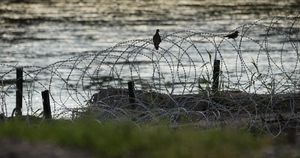Rising tensions between North Korea, the U.S., and South Korea have been dominating headlines, as both sides engage in military exercises and contentious propaganda actions. With accusations flying and military drills at the forefront, the Korean Peninsula finds itself once again at the center of global attention.
Just recently, on May 26, 2024, North Korea's Ministry of Defense took to the airwaves, claiming the U.S. and South Korea were ramping up reconnaissance activities near the heavily contentious inter-Korean border. This accusation, communicated through state media, emphasized how aerial espionage from the allies violated North Korea's sovereignty and security interests.
North Korea's Vice-Minister of National Defense, Kim Kang Il, laid out specific instances of these alleged infringements. Between May 13 and May 24, 2024, it was reported the U.S. deployed at least 16 strategic reconnaissance aircraft, including RC-135s and U-2S planes, as well as RQ-4B drones, soaring over the Korean Peninsula. Adding fuel to the fire, South Korean naval forces allegedly increased their patrols, frequently breaching North Korea's maritime borders, provoking strong rhetoric from Pyongyang.
The North Korean regime doesn’t just stop at airspace violations; it’s also taking actions like sending balloons loaded with propaganda and supplies across the border—sometimes carrying garbage—intensifying the already strained relations. Notably, North Korea retaliated this week by sending 260 balloons filled with trash back over the border, which inconvenienced residents near the DMZ and grounded them indoors as they faced waste build-up around their communities. This tit-for-tat dynamic reflects methods both countries have used for decades, showcasing their hostile communication through age-old tools.
Meanwhile, Pyongyang's military agenda has included significant actions such as launching military satellites, conducting ballistic missile tests, and even testing underwater nuclear drones. These provocations have prompted South Korea to tighten its grip on alliances, particularly with the U.S., resulting in joint military drills perceived as preparation against North Korea’s rising nuclear threat. Yet, from North Korea's perspective, the drills are not mere precaution; they signal intentions of invasion. Kim Jong Un made his stance clear back on January 15, 2024, when he called for constitutional revisions to officially name South Korea as North Korea’s principal adversary, citing Seoul's alliances with foreign powers.
Moving forward through history, moments of cooperation have occasionally punctuated this bitter rivalry. The Inter-Korean Summit of 2018 stands out as one of those rare high points. It marked the first time since 2007 for the two leaders to meet, where Kim Jong Un made history by stepping onto South Korean soil. The summit embodied hopes for peace and reunification, memorialized through the Panmunjom Declaration for Peace, Prosperity, and Unification. Yet, those hopes waned when North Korea chose to suspend commitments from the declaration back on November 23, 2023.
President Yoon Suk Yeol of South Korea, who succeeded Moon Jae-in, the pro-engagement leader, proposed significant measures back in August 2022 to deal with North Korea's nuclear threat. Yoon's ideas revolved around practical denuclearization exchanges, offering North Korea assistance with food programs, energy infrastructure improvements, and modernization initiatives. This approach aimed to create mutual benefits, which could lay the groundwork for improved inter-Korean relations.
Contrastingly, the recent military collaboration between the U.S. and its allies has also intensified. An American aircraft carrier, the USS George Washington, has been leading exercises with South Korea and Japan as concerns about North Korea escalate. This exercise, dubbed Freedom Edge, serves as the second iteration of trilateral drills reflecting the deepening military alignment among these nations. Initiated on June 2024, this series aims to project their united front against perceived threats arising from North Korea's recent military undertakings.
The Freedom Edge exercise showcases naval and air operational capabilities, now integrating advanced aircraft like the F-35s. Reports have highlighted how these exercises are pivotal for the military readiness needed to defend peace and security across the region, including the Korean Peninsula. Undeniably, each drill heightens anxieties on both sides, as North Korea consistently frames such activities as rehearsals for invasion.
Most recently, on October 31, 2024, North Korea engaged the world by test-firing its largest intercontinental ballistic missile, the Hwasong-19, which it claims has the potential to strike the U.S. mainland effectively. This missile launch coincided with the B-1B bomber's arrival, equipped with similar capabilities, to conduct operations near the Korean Peninsula, demonstrating the U.S. commitment to its allies.
The patterns of exchange between North and South Korea and their respective allies suggest more than just geopolitical maneuvering; they seem indicative of deeply entrenched historical grievances with periodic glimmers of hope. The rhetoric and actions taken by both sides often signal heightened tensions, but they also beg the question—can dialogue and cooperation be revived? The need for diplomatic initiatives looms larger each day, providing the fertile ground for collaborative efforts like the 2018 summit or the more recent proposals for increased economic cooperation.
Looking through this complicated lens, the call for mutual dialogue is more pertinent than ever. Between balloon warfare, missile tests, and military drills, the daily lives of those living along the demilitarized zone remind us of the stakes. Hence, as military posturing continues, so does the pressing need to find avenues for non-combative solutions—solutions grounded fundamentally in peaceful negotiation and economic collaboration. The endurance of these historic rivalries emphasizes the importance of seeking not just temporary ceasefires but long-term strategies for coexistence on the Korean Peninsula.



